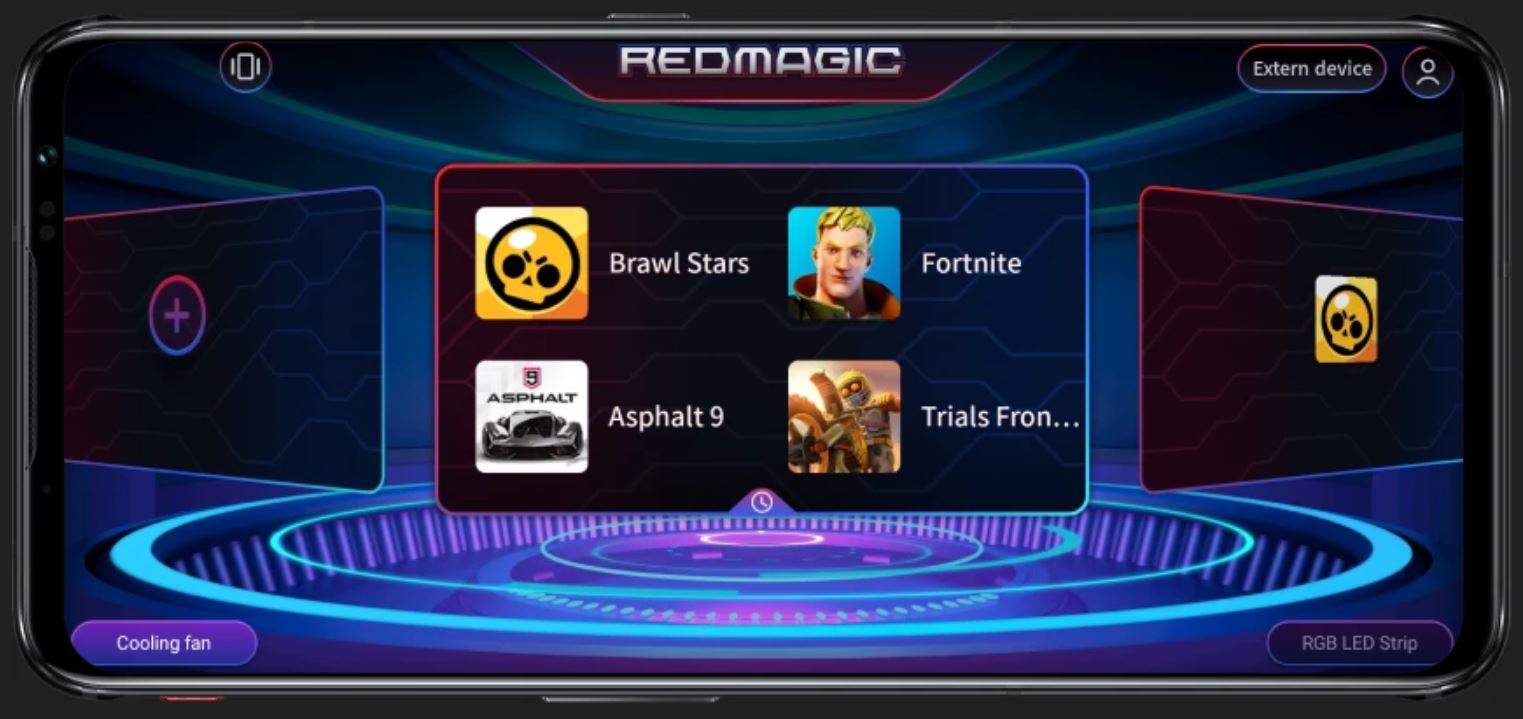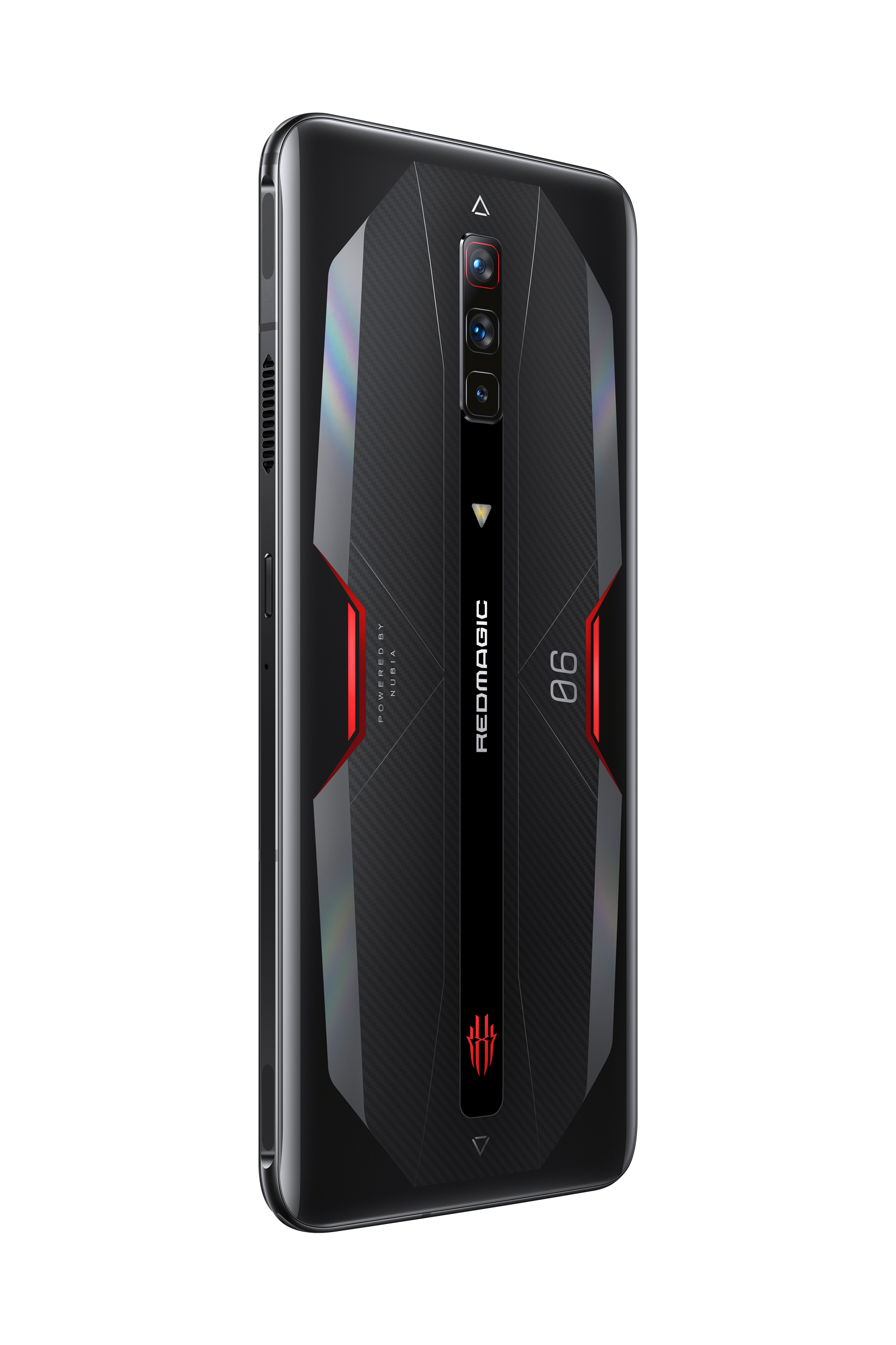In a world of bland glass slabs, the ZTE Red Magic 6 Pro 5G stands out. No, it shouts out, “Look at me. I am different, special and damned powerful”. With its faux carbon-fibre glass back, RGB LEDs, shoulder trigger buttons, alloy frame and massive 6.8″ 165Hz AMOLED screen, it is built to appeal to mobile gamers. But why should they have all the fun?
Everyday users will find benefits in many of the Red Magic 6 Pro’s other attributes. Under the bonnet is the 2021 flagship Qualcomm SD888 5G powerhouse chip, 16GB of RAM and 256GB storage, a turbofan cooling system, tri-camera array, Android 11 and some cool screen themes. It is certainly desirable.
In this review, our focus will go beyond the 6 Pro’s gaming chops (specialist gaming publications can give you all the synthetic benchmark speeds), to look more broadly at the hardware and software and whether they mesh well.
First impressions are that, while the ZTE RedMagic 6 Pro 5G is perfect for gamers who want grunt and street cred, there are smoother top-spec ‘daily drives’, such as the Samsung Galaxy S21 Ultra and OPPO Find X3 Pro. Don’t let us discourage you though – if you want a cool-looking, hot powerhouse, it’s hard to go past this new ZTE.
ZTE Nubia RedMagic 6 Pro 5G Model NX669J-UN Dual Sim, Eclipse Black, 16/256GB
| AU Website | here |
| US Site | here for more information |
| Price | $1499 plus a range of accessories |
| From | JB Hi-Fi “Eclipse Black’ only for Australia |
| Warranty | 2-years ACL on phone and battery and 12 months on accessories |
| Country of Manufacture | China |
| Company | ZTE Corporation is a public listed telecommunications technology company on both the Hong Kong and Shenzhen stock exchanges. For many years it has provided white-label smartphones and modems to Australian Telcos. ZTE can’t participate in Australian and US telecommunications infrastructure (like 5G), but its smartphones are not part of the US Entities list and can use Google Android and Google services. |
| More | You can read more GadgetGuy ZTE news and reviews here |
A word on ZTE and genuine products
Since 2013, we have reviewed many of its smartphones and Telstra, Optus and other white-labelled ZTE phones, including the current Telstra Tough Max 3 and 4GX and 5G Wi-Fi modems. On the whole, they are quality handsets, offering good reliability, value and some extra innovation.
ZTE sells a small range of retail handsets, such as the $499 4G Axon 20, which is one of the first to have an under-glass (no hole) selfie camera. It owns the gaming brand Nubia, of which the Red Magic 6 Pro is the latest.
We caution you that JB Hi-Fi is the sole authorised Australian reseller, and that the model under review here has heavily customised Australian firmware, no app bloatware, and provides full support for Australian networks. Under ‘About Phone, Certification Mark’ is the word ‘Australia’ and the RMC compliance C-tick.
Don’t buy a so-called called global version or a unit offering 12GB storage, or marked with the words ‘Tencent Games’ from online merchants like Kogan, Dick Smith and others. You won’t get an Australian warranty; won’t be able to connect to 5G networks; won’t get over-the-air firmware updates.

First impression
We received more than a bit of excitement from the big, black and brooding Red Magic 6 Pro retail box. It is a 169.9 x 77.2 x 9.7mm x 220g behemoth. We like big phones, and it is pretty comfortable in our average-sized hands.
It oozes a good build quality, and the two-year warranty tells you ZTE has confidence in this handset. Please note that our review sample was an engineering version, and some extra OS features will be in the retail release. For example, you will be able to change from the Nubia launcher to Nova and others. Note that other launchers may not support all Nubia features, such as gesture navigation and GameSpace.
When you set it up, Nubia Launcher will ask for various permissions. Despite having a healthy privacy paranoia, we granted permissions to the phone, camera, and location. In a more extended test, we will disable these and update this review if it causes issues.
Frankly, our only concern is that gamers can be clumsy, especially if they are energetically into the game. Please use the gel bumper case (supplied) and the Red Magic 6 Pro handle PC+TPU protective case supplied). Yes, it makes the phone bigger, but is also the only way to attach the Pro Handle Controllers (get a grip!).

Screen – superb for gamers
| 2400 x 1080, 20:9 AMOLED and always on display |
| 165Hz refresh and 360/500 multi/single touch, 8ms G-t-G |
| 10-bit, 1.07 billion colours |
| 122% DCI-P3 (support up to 1080p, HDR10+ playback Widevine L1, HDCP 2.3) |
| 172% sRGB |
| 630nits max; 550nits typical, 4,096 levels of smart brightness control; Infinite contrast; daylight readable |
| Gorilla Glass (likely V5) |
The Red Magic 6 Pro innovates through being the first 165Hz refresh rate smartphone, which promises super-smooth game play. Few games and apps support this, however, and you will likely run it at 60 or 90Hz until you need otherwise. It does not yet have an adaptive mode (auto-switching between 30Hz, 60Hz, 90Hz, 120Hz, and 165Hz), but we understand that is coming in a firmware update. Until then you’ll need to manually select your refresh rate. Be aware too, that the higher the refresh rate, the higher the battery drain.
In China, 1.5 million gamers (out of 1.5 billion inhabitants) pre-ordered this desirable phone. As noted earlier, they would have been buying the Tencent Games version or the lower cost Red Magic 6 (not the Pro).
We particularly like the choice of Normal, Vivid, Natural, DCI-P3 mode, sRGB mode and infinite colour temperature selection. Delta e is .3 (<4.0 is excellent).
Our tests confirm all of ZTE’s claims – the 20:9 AMOLED display makes for a terrific screen. The Full HD resolution is sufficient for close-range gaming, and avoids taxing the battery like a Quad HD screen would.
Processor – Qualcomm SD888
Until recently, the SD888 (1×2.84GHz, 3×2.42GHz, 4×1.80GHz) was the most powerful system-on-a-chip, but Qualcomm has just announced SD888+ for Q4, 2021. That offers an average 20% improvement in core speed and AI TOPS. In any case, the SD888 is more than suitable for high-level gaming, and it is here, now, in the Red Magic 6 Pro.
Even though this is a 5nm chip, it can run hot under sustained gaming loads. ZTE has ‘IceCube Cooling’ that can reduce CPU temperature by up to 16°. That means:
- Vapour Chamber
- High Thermal Conductivity Copper Foil
- Thermal gel
- Cooling Graphite Thermal Pad
- Aviation Grade Aluminium Heat Sink
- 20,000 RPM, 59-blade fan that you can hear when it is under load.
An optional clip-on ICE Dock with dual 9,000RPM fans and solid-state cooling is capable of up to 25° heat reduction. The dock is USB-C powered and connects via Bluetooth (not tested). During all tests, the system temperatures remained within spec.
GeekBench 5 is 1124/3716. This compares to a Samsung Galaxy S21 Ultra 5G (Exynos 2100) at 1071/3462, and the OPPO Find X3 Pro (SD888) 905/3229.
Adreno 660 – gamer’s choice
- OpenCL score 4477 (Samsung Galaxy S21 Ultra 6909 and OPPO Find X3 Pro is 4574)
- Vulkan score 4175 (Samsung Galaxy S21 Ultra 7687 and OPPO Find X3 Pro is 4463)
The Samsung Exynos 2100 SoC has the current fastest Mali-G78 MP14 GPU. The Adreno 660 is more than capable of playing all current mobile games at higher frame rates.
RAM and Storage – masses!
RAM is a massive 16GB LPDDR5 (fastest) and 256GB (210 free) UFS 3.1. There is no MicroSD slot, but USB-C 3.0 offers 5Gbps/625MBps half-duplex OTG speeds, and you can attach an external SSD up to 2TB. Because there is so much RAM, multitasking is a breeze, and large game apps can load into memory.
Androbench sequential read/write Mbps test
- Internal 1802/712Mbps
- External Orico iV300 1TB USB 3.1 Gen 2 (10Gbps) 350/289
CPU Throttle – insignificant
It starts at 275,023 GIPS, averaging 263,472 for a 6% loss over 15 minutes. CPU temperature did not exceed 51°, which is excellent.
Comms – roll on Wi-Fi 6E
ZTE has stuck pretty closely to a Qualcomm reference design, offering the full Wi-Fi 6E 2×2 MIMO experience. It is lovely to see a Wi-Fi strength of -23dBm and a speed of 2400Mbps at 2 metres from our Netgear RAX200 AX11000 router. But with 6E (and we don’t have a 6E test router yet), it can reach 3600Mbps. What’s more, it holds the speed to nearly 10 metres away. From a gaming perspective, you don’t need to sit on top of the router to get the speed and low latency you crave.
- Bluetooth 5.1 supports SBC, AAC and aptX, but not the low latency codec to gain an advantage. Early firmware defaults to auto selection. We hope later firmware unlocks more of the Qualcomm aptX LL and HD family as well as LDAC.
- GPS is dual-channel, meaning <1m accuracy, and it is by far one of the most responsive we have seen.
- NFC supports Google PayWave.
- Sensors include fingerprint under-display (Goodix optical), accelerometer, gyro, proximity, e-Compass, light sensor and sensor hub. The combo accelerometer/gyro is quite sensitive to movement.
The Red Magic 6 Pro has USB-C 3.0, but it supports Android screen share via a USB-C to HDMI cable. It also supports Chromecast over Wi-Fi. There may be a ZTE PC connect app, but we could not locate it.
4G/5G
- Dual SIM standby (one active at a time), single ring tone
- VoLTE and VoWi-Fi carrier dependent
- LTE Bands: s 1/2/3/4/5/7/8/12/17/18/19/20/26/28/34/38/38/40/41/66 – a world phone
- 5G – Qualcomm X60 Modem – NSA and SA bands can be enabled by firmware. It is capable of mmWave, sub-6GHz and low-band, but at the time of writing specifications don’t reveal which are enabled.*
*Update: ZTE has confirmed it currently has sub-6GHz n78 5G enabled. This is similar to 99% of current 5G phones.
4G Test
We test using a Boost Mobile SIM on the retail Telstra network. Unfortunately the Telstra network in our area has been having major issues for weeks. It appears to have lost Band 28 700Mhz needed for low signal areas. Worse, it’s not rolling back to 3G either. We hope Telstra will fix this sometime this century but there is no ‘intelligent’ person to talk to lodge a complaint. So with only Band 3 2100MHz available we are not getting test results that are comparable to previous phone reviews on GadgetGuy.com.au.
All measurements are -dBM (lower is better) and FemtoWatts (higher is better). For comparison the OPPO has one of the strongest antenna set-ups and uses the same SD888 and X60 modem.
| OPPO Find X3 Pro | ZTE RedMagic 6 Pro | |
| Closest tower | -86/316 | -89/320 |
| Tower 2 | -102/251 | -128/130 |
| Tower 3 | -128/200 | No |
Pretty soon a genuine Australian 5G phone will require n5, n28, n40, n78, n257, n258 and Non-standalone (NSA) and Standalone (SA) compatibility. The standard is n78, but the rest are few and far between
Sound – has potential but needs an EQ
Red Magic 6 Pro uses a pair of Maxim Integrated MAX98927EWX-T Class D amps with IV Sense. EAch amp is matched to its speaker’s resonant frequency within its enclosure, excursion limit, and voice coil thermal limit. That means it can deliver more signal strength to smaller speakers without fear of ‘blowing’ them. This enhances the bass and means that the top and bottom speakers are a close match.
Every gamer wants good sound. Not just music, but for a clear voice and to hear movement, twigs breaking, guns cocking, etc. You won’t quite get that level of detail on the combo stereo earpiece and bottom-firing speaker as you can on earphones. But the speakers have a wider stereo sound stage than most and some ‘directionality’ to help define sound object placement.
It has DTS Ultra X surround sound (up to 7.1 decode), but that only activates with the right content and headphones – again, this is standard for most sound enhancements as there is only so much that micro-speaker can do.
There are three mics – top, right side and bottom that give excellent directionality. It appears to have a degree of ambient noise cancellation that is good for hands-free speakerphone use.
How does it sound? – Good bass/mid but thin on top end treble
The maximum speaker volume is 75dB. That is a tad low, but again we expect this device will mainly use cabled (it has a 3.5mm 8ohm jack) or BT earphones that have significant volume.
Games need bass, and it has solid mid- and high-bass. The frequency response is relatively flat to about 8kHz (treble), where it gradually declines. Technically it is a warm and sweet sound signature, suitable for movies and games. I enjoyed listening to the test tracks here. But an onboard EQ would have been nice.
Battery – power to spare
Before we reveal the test, battery life is mainly around how you use it. A gamer using 120Hz might get 5+ hours of screen-on time, and a typical user with a 60Hz refresh rate may get two to three days.
We understand (but could not find the setting) that you can set the phone to power-only mode for gaming (not charging the battery). That means the overall battery life cycle extends considerably instead of using up more charge cycles.
It has a 5050mAh battery. Given it has the latest 5nm SD888 and a 1080p AMOLED screen, you can expect a reasonable screen-on time.
The supplied charger is 5V/3A/ to 10V/3A (30W) and 12V/2.5A to 20V 1.5A/30W QC 4+ (5) standard. It charges 0-100% in 65 minutes.
It also supports up to 66W quick charge with an optional GaN charger. This uses PD, so any higher capacity GaN charger should work. It requires a USB-C cable capable of 11V/6A
Tests
- Video loop, on-device storage, 60/Hz/50% screen and volume – 19 hours
- YouTube video, Wi-Fi and 50% screen and volume – 12.5 hours
- PC Mark 43.0 battery: 12hours and 25 minutes
- GFX Bench Manhattan 3.1 Battery Test 60Hz – 277.2min/4.54hours/ 3738 frames
- GFX Bench T-Rex Battery Test 60Hz – 625min/10.42hours/3377 frames
- 60Hz battery drain – 13.5 hours
- 90Hz battery drain – 1.5 hours
With heavy game use, it should last 5+ hours, and general for use, around two days.
Special Game Functions
GameSpace mode activates using a red slider switch on the phone. This allows you to organise your games, and:
- Fine-tune performance settings
- Monitor settings (brightness, refresh)
- Record gameplay, create macros and more.
The haptic feedback dual capacitive shoulder trigger buttons have a 400Hz touch sampling rate.
RGB Light: fully customisable light effects. You have four solid colours and three gradients.
There are various accessories, including a RedMagic e-sports handle that uses USB-C and BT.
Build – rock-solid
- 169.86 x 77.19 x 9.7mm x 220g
- Clear TPU phone case provided
- Material: Alloy frame, glass back (faux Carbon fibre)
- The under-glass optical fingerprint was fast and accurate
It is solid enough, but we are concerned that it does not have MIL-STD drop ratings for enthusiastic gamers. Use the protective case, please.
Android
- Android 11 and RedMagic OS 4.0
- Security patch 1/5/2021
- Close to stock Android with a Nubia launcher and heavy-handed approach to icons
The icons are edgy, and the Red Magic OS is not super-polished, but overall it is not too hard to get used to. Certainly no more difficult to master than pure Android that has no UI to smooth over Android cracks.
Red Magic 6 Pro it will get Android 12, probably Q1 2022, and bi-monthly security patch updates. To be competitive with Samsung and OPPO, it needs to have at least two further OS upgrades and two years of security patches.
RedMagic 6 Pro camera
- Wide – 64 MP (bins to 16MP), f/1.8, FOV 78.3° (68.6°), 0.7µm (bins to 1.4), Dual Pixel and PDAF (Super PD Focus), 10x digital zoom, Samsung S5KGW3, 8K@30fps
- Ultrawide – 8 MP, f/2.0, 120˚, 120mm, 1.12µm Hynix HI846
- Macro: 2 MP, f/2.4, 1.75µm, 67.5°, FF, OmniVision OV02A10
- Front8 MP, f/2.0, (wide), 1/4.0″, 1.12µm, FF, Hynix HI846, 1080p@30fps
The camera set-up appears more of an afterthought than a feature, but don’t despair. It is easy enough to point and shoot and takes good photos in most light conditions. It is just not as good as other $1499 smartphone cameras, and I put that down to the firmware and the app. Both can only get better.
The Camera app has a ton of features (above), and their usefulness will vary between users. There’s slow-motion video recording and a whole range of effects for videos and photos that can be fun to play around with. All these things are hidden away in the ‘Camera-family’ section.
Good shot – a slight blurring of the dog’s fur. Bokeh is software-driven and needs a minimum of 2 metres from the lens to the subject or you get reverse-bokeh
We took 20 shots but still could not get a good macro definition. All shots were at approx 4cm Yet this macro shot is perfect.


Some general camera comments
- You can shoot 64MP, but while it has loads of detail, it lacks the AI computational photography enhancements that the 16MP binned shot has.
- On the whole, the primary camera delivers over-sharpened and over-saturated (courtesy of the AI) images. It is not bad, it takes a trained eye to notice these things.
- Access to the wide-angle lens is via the Pro mode section. It should be one of the camera’s default zoom buttons. The sensor is not colour matched to the primary. I suspect that it does not have AI processing. And you cant access it for video. Overall it is almost redundant but is an easy fix in firmware.
- You can capture video at up to 8K resolution at 30fps. Still, you won’t because it is awfully shaky (the SD888 supports Gyro EIS – electronic image stabilisation), but it only seems to cut in at 1080p@60fps or lower. Video in 1080p at 30/60fps is superb.
- The macro feature was unable to focus correctly at 4cm – a firmware issue. Otherwise, I like the spot focus bubble that shows what you are looking at
- Bokeh was the reverse – it focuses on the background and blurs the foreground. We later found that the minimum distance from the foreground subject is two metres for Bokeh to work
To be clear, the camera is adequate, so a 7/10. It could be so much better if ZTE put some effort into the firmware. I have seen similar set-ups on OPPO, vivo and realme that perform brilliantly. Still, the camera is not the primary reason you’ll be buying this device.
GadgetGuy’s take
Following two weeks of use – and coming off the back of Samsung Galaxy S21 Ultra (Exynos 2100) and OPPO Find X3 Pro – we determined that the Red Magic 6 Pro would not be our daily drive of choice. It’s plenty powerful, but the RedMagic OS needs some refinement. For example, the icons are ‘edgy’, and the UI features you get with flagships from Samsung or OPPO, such as adding an inbound call to your Contacts list, are simply not there.
As a gaming-optimised smartphone, however, its appeal extends to a niche of buyers concerned with more than everyday pedestrian needs. For them, the superb screen and touch shoulder buttons make the Red Magic 6 Pro a cool phone with scorching performance.
Rating explanation
Is it a smartphone with gaming benefits, or a gaming device with smartphone benefits?
As a smartphone, its RedMagic OS has a few rough edges and it’s not getting nearly the best results from its camera hardware. If ZTE addresses the former via firmware, it would be near enough to a perfect compromise.
As a gaming phone, its July 2021 specifications are quite unique – especially the 165Hz screen and GameSpace. But its main competitor is the new entry-level ASUS ROG 5. It has a slower 144Hz screen, larger battery and costs $1599 (also from JB Hi-FI). The Ultimate version (not here yet) is estimated to cost nearly $3000.
The Red Magic 6 Pro sits above the standard ROG, so it needs to be on your shopping list. You can compare both at JB.
ZTE’s Red Magic 6 Pro meets or exceeds all test parameters, so we start at a passmark of 8/10. Screen, warranty, expandability, battery life, dedicated GamesSpace and raw power take it to 9+. We are not going to penalise it for the OS or camera because they do the job.

























Wow!
I haven’t paid much attention to new phones (or phone reviews for that matter), since I had to replace a broken one, about 3 years ago.
I thought I was ‘up to date’ with what I perceived to be ‘meh’, ‘incremental updates’ of new features and functions. Reading this review, has blown that thought out of the water.
Kudos to you Sir Reviewer! This was a highly educational read, that reinvigorated my passion for new tech.
This phone has easily double the computing power of my laptop, and reading the specs has left me absolutely salivating!
Thanks again for a great read!
Harry.
My pleasure – our readers appreciate the deep-dive reviews – it helps them decide, free from marketing hype. The ZTE RedMagic 6 is a great phone.